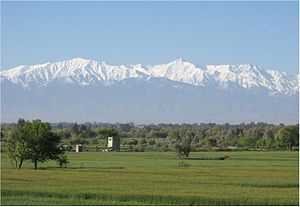Safēd Kōh

Safēd Kōh (Persian: سفید کوه, Urdu: سفید کوہ, "White Mountains"; also known as Spin Ghar (Pashto: سپين غر, "white mountain", the Indian Caucasus as late as the 19th century, the Safīd Mountain Range and as the Morga Range[1]), is a mountain range in eastern Afghanistan and expanding well to North-Western Pakistan.
Its highest peak, straight and rigid Mount Sikaram, towers above all surrounding hills to 4,761 m (15,620 ft) above mean sea level. The Kabul River cuts a narrow trough through the Safēd Kōh mountains to flow eastward into the Indus River; otherwise, the range connects directly with the Shandur Top offshoot of the Hindu Kush mountain system.[1]
The Khyber Pass crosses a spur of the Safēd Kōh range. The closest city near the Safed Koh is Parachinar of Pakistan.
Above the nearly barren lower slopes, forests of pine and deodar cedar thrived on the main range, but devastation during the Afghan civil war reduced timber resources. The valleys still support some agriculture.
According to the United States's military intelligence, many al-Qaeda fighters, including Osama Bin Laden had used the Safēd Kōh range to escape to Pakistan during the Tora Bora offensive in 2001. Since 2004, the Safēd Kōh mountain range had been a pivotal place and theater of many battles fought by the foreign fighters of al-Qaeda and the joint-warfare command of Pakistan Armed Forces to prevent the foreign fighters incursion into Pakistan.
See also
- List of mountain ranges of the world
- List of highest mountains (a list of mountains above 7,200m)
References
- ↑ 1.0 1.1 Safīd Mountain Range in Encyclopaedia Britannica, 2009
-
 This article incorporates text from a publication now in the public domain: Chisholm, Hugh, ed. (1911). Encyclopædia Britannica (11th ed.). Cambridge University Press.
This article incorporates text from a publication now in the public domain: Chisholm, Hugh, ed. (1911). Encyclopædia Britannica (11th ed.). Cambridge University Press.